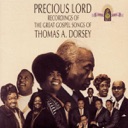Traditional Gospel
Mahalia Jackson sings at Vigyan Bhawan, New Delhi in 1971
U.S. Embassy New DelhiKey Attributes of Traditional Gospel
Select to filter timelineThemes
- Religion/Faith
- Migration
- Entertainment
Musical Features
- Rhythms
- Melody
- Harmony
- Meter
- Beat
- Improvisation
Instruments
- Drums
- Organ
- Piano
- Voice
“Gospel music was different from the approved hymns and spirituals. It had a beat. Many ministers and other folks genuinely believed gospel music was wrong.”Thomas DorseyPioneering Gospel Music Composer
“While Mr. Dorsey brought to the religious songs rhythmic and melodic patterns taken from the secular world, he nevertheless brought also an intense religious devotion to them.”John W. WorkComposer, Choral Director, Scholar
Black denominational churches in Chicago quickened to new sounds on Sunday mornings in the 1930s. Later called gospel music, the songs of former blues and ragtime pianist Thomas A. Dorsey pioneered a rockin’ style of religious music that borrowed from the gospel hymn tradition of Charles Albert Tindley and the emotionally charged improvised singing of Holiness-Pentecostal churches.
Context and History
Thomas A. Dorsey, known as the “Father of Gospel,” fused blues-styled melodies and harmonies, blues and ragtime rhythms, and texts that testified to the powers of Jesus Christ, who provided earthly solutions to daily struggles. Despite the “good news” message in Dorsey’s songs, most ministers of independent Black churches initially rejected his songs. They did not conform to the sound of standard hymns and anthems, and their musical style had a “secular” beat. Among Dorsey’s well-known compositions are “Take My Hand, Precious Lord,” “There’ll Be Peace in the Valley for Me,” “Hide Me In Thy Bosom,” and “Old Ship of Zion.” Dorsey used creative approaches to introduce this music to church congregations. Along with Sallie Martin, Mahalia Jackson, and Willie Mae Ford Smith, Dorsey sang his songs on the sidewalks outside of churches, at church conventions, and at the National Convention of Choirs and Choruses that he founded with others in 1922.
Chicago, with its recording and publishing companies, quickly grew as a center for gospel music. The migration of rural Blacks between 1910 and 1920 more than doubled its population of African Americans, and the spread of gospel music through the National Baptist Convention and the National Convention of Choirs and Choruses created a market for it. Dorsey opened his own publishing house and local gospel songwriters Roberta Martin, Kenneth Morris, and Lillian Bowles became active in the publishing business. Gospel songwriters Lucie Campbell and William Herbert Brewster advanced the tradition in Memphis. In the 1930s, jubilee quartets that traditionally sang spirituals began to include Dorsey’s songs and their radio broadcasts spread the “good news.” By the end of the decade, several female gospel groups and male gospel quartets began forming, and larger choirs followed. They joined the gospel train to institutionalize this tradition within African American communities as did James Cleveland when he organized the Gospel Music Workshop in 1968 to preserve the gospel tradition and to feature new talent. His programs influenced the formation of many community gospel choirs throughout the country.
Since the 1970s, with the release of “Oh Happy Day” (1969) by the Edwin Hawkins Singers and the global popularity of the Hollywood film Sister Act, Gospel has become a worldwide phenomenon. Gospel choirs have proliferated in countries across the Atlantic and Pacific oceans. Gospel music can be heard 24 hours daily on radio and television and is performed at major venues throughout the country. It also provides soundtracks for commercials and Hollywood films and has become a big-time moneymaker for the music industry.
Musical Features/Performance Style
“It’s [Black gospel music] not written for trained musicians…A musician is a slave to the notes…it’s written for a person who can get the melody and words and interpret the song for himself.”Kenneth MorrisGospel Songwriter-publisher
Gospel music scores provide only a skeletal outline of the basic melody, harmony, and rhythm around which the performers improvise. Musicians may freely change keys, substitute meters, and increase or slow down the tempo. The piano, the Hammond B3 organ, and eventually drums became the core instruments associated with traditional gospel.
Lyrics
The texts that Thomas Dorsey introduced to gospel music were inspired by stories and themes from the New Testament, refracted through the prism of African American experiences.
Bibliography
- Boyer, Horace Clarence. How Sweet the Sound: The Golden Age of Gospel Music. Washington, D.C.: Elliot & Clark Publishing, 1995.
- Burnim, Mellonee V. “Gospel” in Mellonee V. Burnim and Portia K. Maultsby, eds. African American Music: An Introduction. 2nd ed. (New York: Routledge Press, 2015), 189-212.
- Harris, Michael W. The Rise of Gospel Blues: The Music of Thomas Andrew Dorsey in the Urban Church. New York: Oxford University Press, 1992.
- Reagon, Bernice Johnson, ed. We’ll Understand It Better By and By: Pioneering African American Gospel Composers. Washington, DC: Smithsonian Institution Press, 1992.







